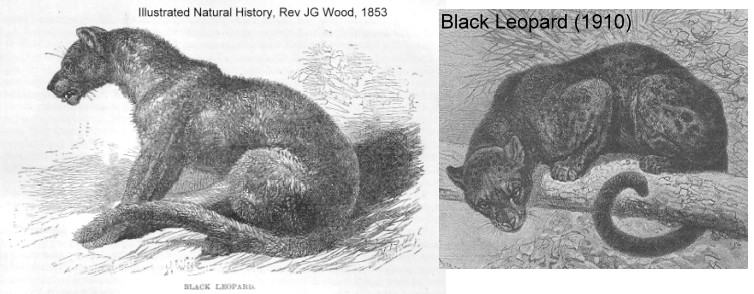
|
MUTANT LEOPARDS |
Mutants are natural variations which occur due to spontaneous genetic changes or the expression of recessive (hidden) genes. Recessive genes show up when there is too much inbreeding, either in isolated wild populations or in captive populations. Albinism (pure white), chinchilla (white with pale markings) and melanism (black) are the commonest mutations. Erythristic (red), leucistic (partial albinism/cream) and maltesing (blue) are also reported in big cats. Sometimes the markings are aberrant e.g. too sparse or too heavy (abundism), giving the appearance of a pale or dark individual. White, black, red, blue or cream mutations are similar to those found in domestic cats. Sometimes the pattern is different from normal. As well as anomalous colours, there are abnormally large or small individuals, longhaired individuals, short-tailed or even tail-less individuals. All of these occur in domestic cats so why are they less common in big cats? Wild cats displaying these traits may be less likely to survive to pass on the traits. In captivity, humans control which traits are bred, hence the multitude of domestic cat colours and types. In the wild, nature selects against any trait which does not enhance the animal's survival chances.
In the past, the obvious reaction to any unusual big cat was to shoot it for the trophy room. As a result, many interesting mutations may have been wiped out before the genes were passed on. Some colour mutations which would disadvantage a wild big cat are bred in captivity and are not viable in the wild. It is questionable whether these mutants should be perpetuated for the sake of curiosity or aesthetics alone.
I am grateful to Paul McCarthy for researching and providing extensive material on leopards.
BLACK LEOPARDS
Leopards are most commonly buff/tawny with inky black spots arranged in rosettes. Melanistic leopards are relatively common and are bred in zoos and as exotic pets (black panthers). Black leopards are reported from moist densely-forested areas in south-western China, Burma, Assam and Nepal; from Travancore and other parts of southern India and are said to be common in Java and the southern part of the Malay peninsula where they may be more numerous than spotted leopards. They are less common in tropical Africa, but have been reported from Ethiopia (formerly Abyssinia), the forests of Mount Kenya and the Aberdares. One was recorded by Peter Turnbull-Kemp in the equatorial forest of Cameroon.
A melanistic leopard cub has been observed in Ol Pejeta Conservancy in Kenya. Although black leopards are common in India, where the colour may be advantageous in forested conditions, confirmed sightings in Kenya are so rare that they were not scientifically documented or photographed/ filmed for over 100 years, although there had been reports of sightings in and around Kenya for decades.
According to the Illustrated Natural History by the Rev JG Wood (1853, 1874): There are some [Indian] Leopards whose fur is so very dark as to earn for them the name of Black Leopard. This is probably only a variety, and not a distinct species. Although at first sight this Leopard appears to be almost uniformly black, yet on a closer inspection it is seen to be furnished with the usual pardine spots, which in certain lights are very evident. There have been often exhibited sundry Leopards of an exceedingly dark fur, and yet partaking largely of the distinct spottings of the ordinary Leopard. These were a mixed breed between the Black Leopard and the Leopard of Africa. The black variety of this animal is found in Java, and has by some authors been considered as a separate species under the title of Felis (Leopardus) melas, the latter word being a Greek term, signifying black.
At The Zoo. The Cat Family In Its Many And Curious Varieties. St Louis Globe Democrat, 22nd August 1885 (From the Philadelphia Ledger.)
There are three leopards at the "Zoo," a large Indian male and two African females. The visitor to the garden is not mistaken when he forms the opinion from the appearance of those animals that they are even more ferocious and intractable than the lion or tiger. The black variety of leopard is found principally in Java. Under a strong light spots may be detected in this animal corresponding with those on other leopards. The black leopard is not a distinct species, as it and leopards of the ordinary appearance may be born of the same dam and have the same sire.

The spotted pattern is still visible on black leopards, especially from certain angles where the effects is of printed silk. Black leopards are caused by a recessive gene and always breed true. It is sometimes erroneously suggested that black leopards are more fertile than the normal tawny form. According to Funk And Wagnalls' Wildlife Encyclopedia, black leopards are less fertile than normal leopards having average litters of 1.8, compared to 2.1. This may be due to their highly strung nature and finding captivity more stressful. They sometimes give the impression of being more fertile because they are selectively bred as exotic pets and because recessive genes breed true i.e. two black leopards will always produce black cubs. Captive black leopards may be more highly strung than spotted leopard; probably due to inbreeding. Because the animals are nocturnal hunters, melanism does not necessarily impede survival. Mounted specimens of black leopards are prone to fading, giving the impression of chocolate brown leopards and red leopards.
Most other colour morphs of leopards are known only from descriptions, paintings, trophy hunters or museum specimens. There have been very rare examples where the spots of a normal black leopard have coalesced to give a jet black leopard with no visible markings. Pseudo-melanism (abundism) occurs in leopards. The spots are more densely packed than normal and merge to largely obscure the background colour. They may form swirls and, in some places, solid black areas. Unlike a true black leopard the tawny background colour is visible in places. One pseudo-melanistic leopard had a tawny orange coat with coalescing rosettes and spots, but white belly with normal black spots (like a black-and-tan dog).
WHITE-FOOTED LEOPARD
Leopards with white paws. These photos provided by Rozenn Izel show a male Amur leopard named Rokot (born 28/04/2015) at "Le parc des f lins" near Paris in France. He has 4 white paws (mitts) and has black markings on a white chest and belly. Most leopards buff toes and creamy underparts, but it is not uncommon for Amur leopards to have "whited" underparts and some white toes. Rokot came from Nikolaev Zoo, Ukraine.
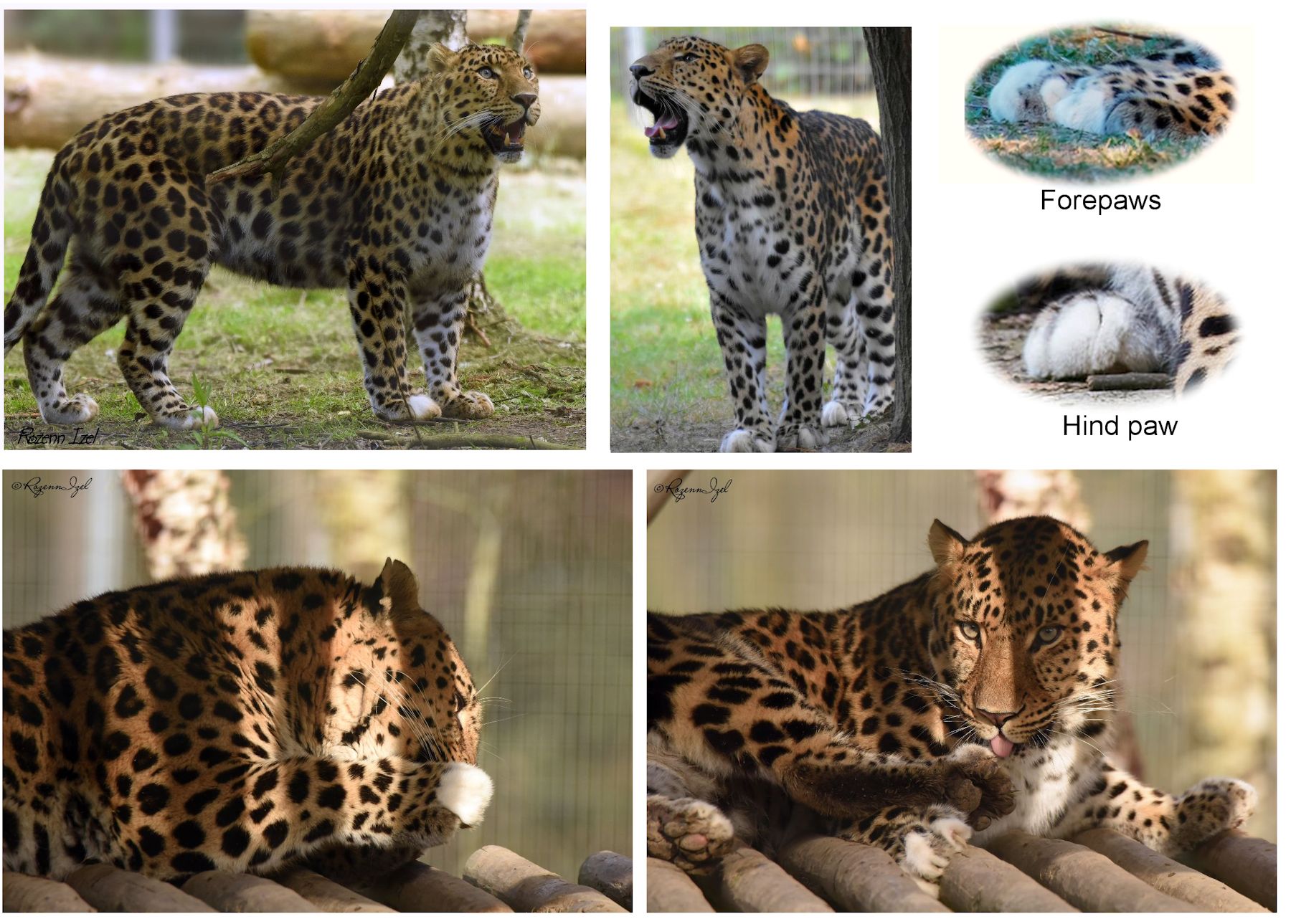
Xana Akai sent me these photos of a piebald leopard pelt. The white markings are asymmetrical and show no sign of bleaching; the markings follow the normal pattern of white distribution in "tuxedo" cats. The eyes and ears are not original, but the white markings appear natural. The chest and belly sections are missing, but would almost certainly have been white. Unlike the "whited" Amur the underparts and mitts are unmarked.
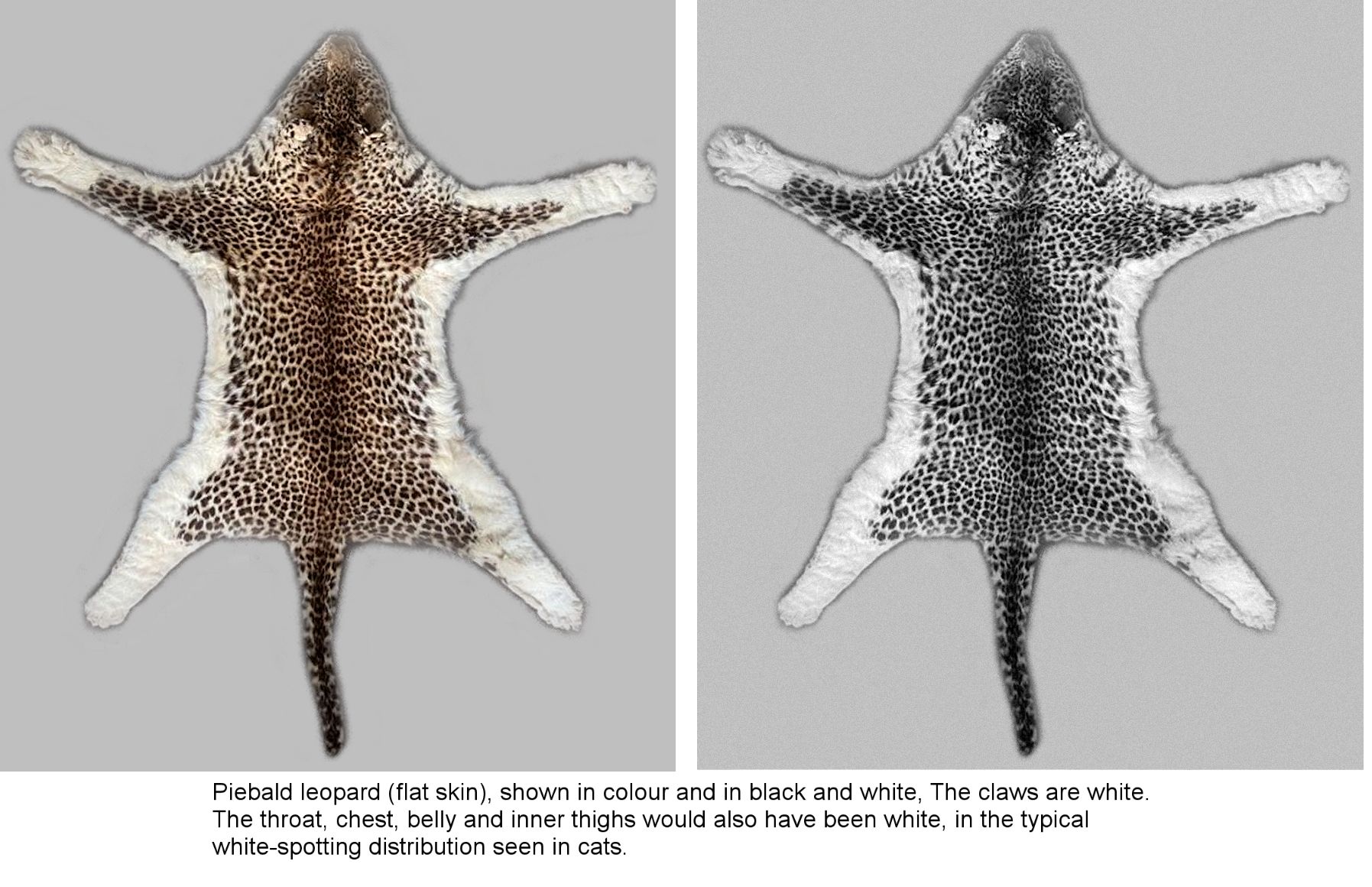
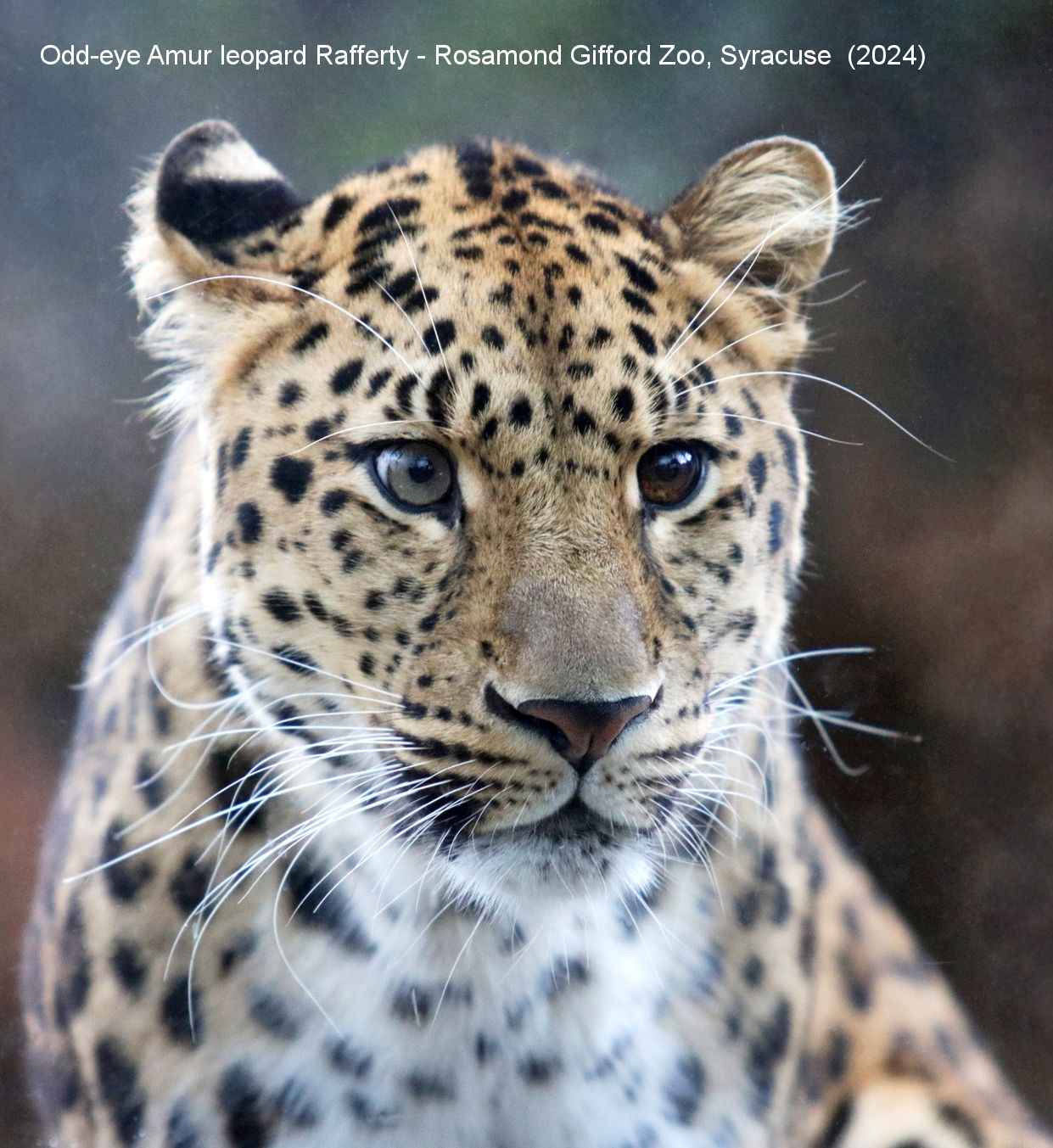
PSEUDO-MELANISTIC LEOPARDS
ON A REMARKABLE VARIETY OF THE LEOPARD (FELIS PARDUS), OBTAINED IN THE EAST OF THE CAPE COLONY. BY B. TRIMEN, F.R.S., F.Z.S. (Proceedings of the Zoological Society of London, November 20, 1883), [Received September 12, 1883.]:- In the Albany Museum, at Grahamstown, I have lately seen a mounted skin of Felis pardus, which differs much from any specimen that I have previously met with. It is that of a full-grown animal, but its sex is not noted. In this example the most noteworthy character is the abundance of small black simple spots, almost to the exclusion of the ordinary "rose" or "ring" spots. The small spots are very numerous on the forehead and sides of the head, all along the dorsal tract, on both sides all over the middle of the body, and also on the shoulders and outer sides of the fore legs. Imperfect rose-spots are observable on the paler spaces on the sides of the neck, of the body behind the shoulders, and of the thighs. The fur of the tail is of a sandy colour, spotted and mixed with fuscous, the terminal portion being grizzled fuscous.
This specimen is labelled "Bucklands, near Koonap presented by Mr. Buckley, August 1870." The Catalogue of the Albany Museum mentions it as a cross between the ordinary and black Leopards ; but I believe the well-known black form of the Leopard has never been met with in South Africa (if in Africa at all), the specimens recorded being from India, Java, and Sumatra. I should thus prefer to regard this Cape specimen as an interesting aberration in the direction of the complete melanism of the so-called Felis melas.
NOTE ON A SUPPOSED MELANOTIC VARIETY OF THE LEOPARD, FROM SOUTH AFRICA. BY DR. A. GUNTHER, F.Z.S., Proceedings of the Zoological Society of London, March 3, 1885, [Received March 3, 1885.], (Plate XVL):- A few days ago, Mr. F. Bowker brought to me the flat skin of a "rare Leopard" which he had obtained at Grahamstown. The animal had been killed in a hilly district covered with dense scrub and situated at a distance of about forty miles from the town. On further inquiry I learned that a second specimen had been obtained in the same district, and is at present preserved in the Museum of Grahamstown [This is evidently the same specimen which was described by Mr. Trimen in Proc. Zool. Soc. 1883, p535]; that the ordinary kind of Leopard is common in the locality, that the Cheetah is very scarce, and that the Lion has been entirely exterminated for a considerable period.
The points in which the skin differs from the ordinary type are the following :
The ground-colour is tawny with a rich orange gloss about the shoulders. Of the rosettes only a few indications are preserved, namely on the haunches, where two are visible on the right side, whilst they form an irregular confluent pattern on the left. Remains of rosettes are also visible, one on each shoulder close to the verticelli of hairs which are usually developed in this place in the Leopard, Lion, &c. Two pairs of similar rudimentary rosettes succeed these at intervals of about 10 inches. The remainder of the rosettes are broken up into, or replaced by, innumerable small separate spots, which are most distinct in and behind the region of the shoulder, and on the outer sides of the legs. They are more diffuse on the flanks, where they mix with the ground-colour, producing a brownish tinge. Finally, on the back, from the forehead to the sacral region, they are move or less confluent, so that the whole of the back appears to be of black colour, which is most intense above the lumbar region. A few black spots on the upper lip, a conspicuous black spot above each eye surrounded by a light yellowish ring, and a large black spot on the back of the ear are present as in Leopards with typical coloration. On the other hand, the tail differs in a remarkable manner, it being fulvous for its first two thirds, which colour gradually changes into pale grey; the whole tail is sprinkled with numerous very small and clearly defined spots, the extreme tip being black. Chin, chest, belly, and inside of the legs white with large black spots as in the ordinary Leopard. Whiskers and claws white, hair between the foot-pads black. The hairs are of about the ordinary length, with a very thick underfur on the sides of the body.
The measurements of the flat skin are as follows: Head and body 4 feet 1 inch, tail 2 feet 6 inches; distance of central line of back from the fore toes 2 feet 6 inches.
In endeavouring to throw some light on this extraordinary deviation from the ordinary type, we are almost entirely limited to the evidence to be gleaned from the specimen before us. The possibility of its being a hybrid between the Leopard and one of the other large feline animals of South Africa is to be considered. There is a very evident mixture of two patterns of coloration, viz. of that in which the ornamental colour appears in the form of rosettes, and that of simple black spots as in the Cheetah. Yet the whole build of the animal and the structure of the typically feline claws prevent us from assuming that the Cheetah might be one of the parents. It would be more within the bounds of possibility that our specimen is the offspring of a Leopard with a Lioness which had strayed so far southwards, the African Lion being frequently found with a very dark dorsal region and with the long hairs of a more or less intense black; also the bright tawny ground-colour of the shoulder in our specimen is very Lion-like. But it would be extremely hazardous to found an opinion on such slight grounds, the more so as we cannot find any trace of structural leonine characters.
The hairs consist of a soft underfur of fine wool-hairs, mixed with stouter hairs; the latter cannot be distinguished microscopically from those of the ordinary Leopard; and both are almost identical with, perhaps a little more slender than, those of the Lion.
It is a well-known fact that the Asiatic Leopard exhibits a decided tendency to melanism; and it is stated that the black Leopards are found chiefly in forest-districts of considerable elevation. So far, the conditions under which melanism appears in the Asiatic Leopard seem to be similar to those under which our specimen was reared. On the other hand, the abnormal coloration affects the ornamental pattern of the Asiatic Leopard in a different fashion from that observable in our specimen. In the former the black colour is equally diffused over the whole body, the rosettes retaining their shape and number, and shining with a more intense black through the ground-colour. This is a very different pattern from that of our specimen. Nevertheless, considering all circumstances, I have no better opinion to offer than this, that the specimen is an instance of incipient melanism the first appearance of the melanotic tendency which is so strongly developed in Asiatic individuals of this widely spread species.
SECOND NOTE ON THE MELANOTIC VARIETY OF THE SOUTH-AFRICAN LEOPARDBy Dr. A. Gunther, F.Z.S., Proceedings of the Zoological Society of London, April 6, 1886, [Received March 26, 1880.]:- By the last South-African mail I have received from Mr. N. Abraham, President of the Graham's-town Natural History Society, a letter with photograph enclosed, which gives more positive information about the variety of the Leopard of the district of Albany, mentioned by Mr. Trimen in Proc. Zool. Soc. 1883, p. 535, and described by myself, ibid. 1885, p, 243, pi. xvi. The skin in Mr. Abraham's possession leaves hardly any doubt that we have before us a case of incipient melanism, which, if the family in which the melanotic tendency showed itself had been left undisturbed, might have been developed into as complete a condition of melanism as is occasionally found in the Asiatic Leopard. Mr. Abraham writes as follows :
Graham's-town, S. A., March 1st, 1886.
" To Dr. A. Gunther, F.Z.S.
"Dear Sir,
Knowing that you are interested in the black variety of Leopard found in the district of Albany, I write to tell you of a beautiful skin which I have in my possession and also to send you a photograph of the same. I had the flat skin photographed on purpose that I might send you a copy, as I thought a photo would convey a good description and save many words. It will, however, be necessary for me to say that the blackness of the skin is more dense than appears in the photo. The gloss upon the skin prevented the photographer from giving a true idea of the beautiful black, which is dense in many parts. There are no rosettes or spots at all on the larger portion of the skin; in this the photograph is quite correct. The spots do not even show through the black as in the black Leopard of Java. The tail has had its point taken off; this accounts for its shortness,
The measurements of the flat skin are as follows: Head and body 4 feet 1 inch; portion of tail 1 foot 4 inches; distance from fore toes to central line of back 2 feet 3 inches. On the black portion of the skin the hair is short with a very thick underfur. The tail is not black, but very dark, and has a somewhat remarkable appearance. The markings on the front legs differ very much from the markings on the hind legs, being very tawny with scarcely any dense black, while the hind legs are slightly tawny with clear markings of black and white. The whole skin is very handsome and remarkable. The specimen was caught by a native in a trap and then shot. The native took the tip of the tail and the claws for trophies. It was caught about twenty miles from Graham's-town. I have made many inquiries respecting this peculiar variety with the hope of forming some good theory explaining this deviation from the ordinary type. I can only trace four specimens, viz. : The skin in the Graham's-town Museum (this is a good specimen, but not nearly so black as the one in my possession); another was taken to England by Mr. Bowker, and is in the British Museum; a third was sold some time ago at a Church bazaar, but I cannot trace it; and the fourth I have. I do not know of any other for certain. All these have been shot in, or about the same district. The one I have came from Collingham near to Graham's-town. I am told that there are two living specimens still in the district, and there may be more, but these two have been seen, but not captured. I am still on the trail for more information; at present I cannot give any certain or probable account of the origin of this variety, but I write this to you and shall be glad to forward you further information when I have completed my investigation.
I remain, dear Sir, Yours sincerely, (Signed) Nendick Abraham, Pres. Graham s-town Natural History Society."
Proceedings of the Zoological Society, May 3, 1887.: "The case [. . . ] seems much to resemble those of the singular form of Cheetah (Felis lanea of Sclater), of which only five specimens are known, all from the very limited area of Nel's Point, in the Beaufort District of the Cape Colony, and the equally aberrant Leopard (F. pardus, L., var. melas ; see Trimen, P. Z. S. 1883, p. 535, and Gunther, P. Z. S. ]885, pi. xvi. p. 243), of which only three examples are known, from the neighbourhood of the Koonap River, in the Fort-Beaufort District on the eastern side of the Cape Colony. It is very noticeable that, in all three cases, the abnormal form does not replace the normal one to which it is so nearly related, but occurs in the midst of the latter, quite isolated, yet appearing to maintain and perpetuate (albeit in but very few individuals) its peculiarities of colouring or of pattern."
This indicates a (probably recessive) gene was present in the leopard population and that the variant leopards showed up when two carriers of the gene bred together. Accounts of these leopards were widely repeated in later publications.
In Animal Life and the World of Nature (1902 1903), a pseudo-melanistic leopard with heavily speckled markings was described: A very curious (and seemingly new) variety - if not sub-species of the leopard is found in Northern Cape Colony and perhaps in Basutoland. It is of large size, but the rosettes have changed into innumerable tiny black spots thickly scattered over the rather umber-tinted fur of the upper parts. The bold black stripes of the throat and the black spots on the white belly are retained. In fact it is a parallel case to the Servaline Cat, which differs only from the common Serval by the substitution of many little spots on a dusky ground for the large clear black spotting on yellow. It would almost seem as though (but for the hindrance of man and his attempts at exterminating) a new species of leopard on rather leonine lines was being developed under our eyes in South Africa. With this exception the leopards of all Africa, and of India, Ceylon and Malaysia, are absolutely indistinguishable in appearance, size, and markings, though all these regions offer two distinct and similar types, according as the leopard in question inhabits the open or the forest country.
In The Field No 2887, April 25th, 1908, Henry Scherren wrote "By the kindness of Dr P Chalmers Mitchell, Secretary of the Zoological Society, Mr Smith's drawing of a melanotic leopard obtained at Grahamstown is here reproduced. When Dr Gunther described that animal (Proceedings of the Zoological Society, 1883, p 243) the question of hybridity with a cheetah or a leopard for sire was discussed, but rejected in favour of the view that the animal was an instance of incipient melanism, the ground colour being tawny, with an orange gloss about the shoulders. With the permission of Dr Mitchell I shall shortly exhibit at a scientific meeting of the Zoological Society black leopard skins obtained in quite a different part of Africa" (While relatively common in India, black leopards are uncommon in Africa).
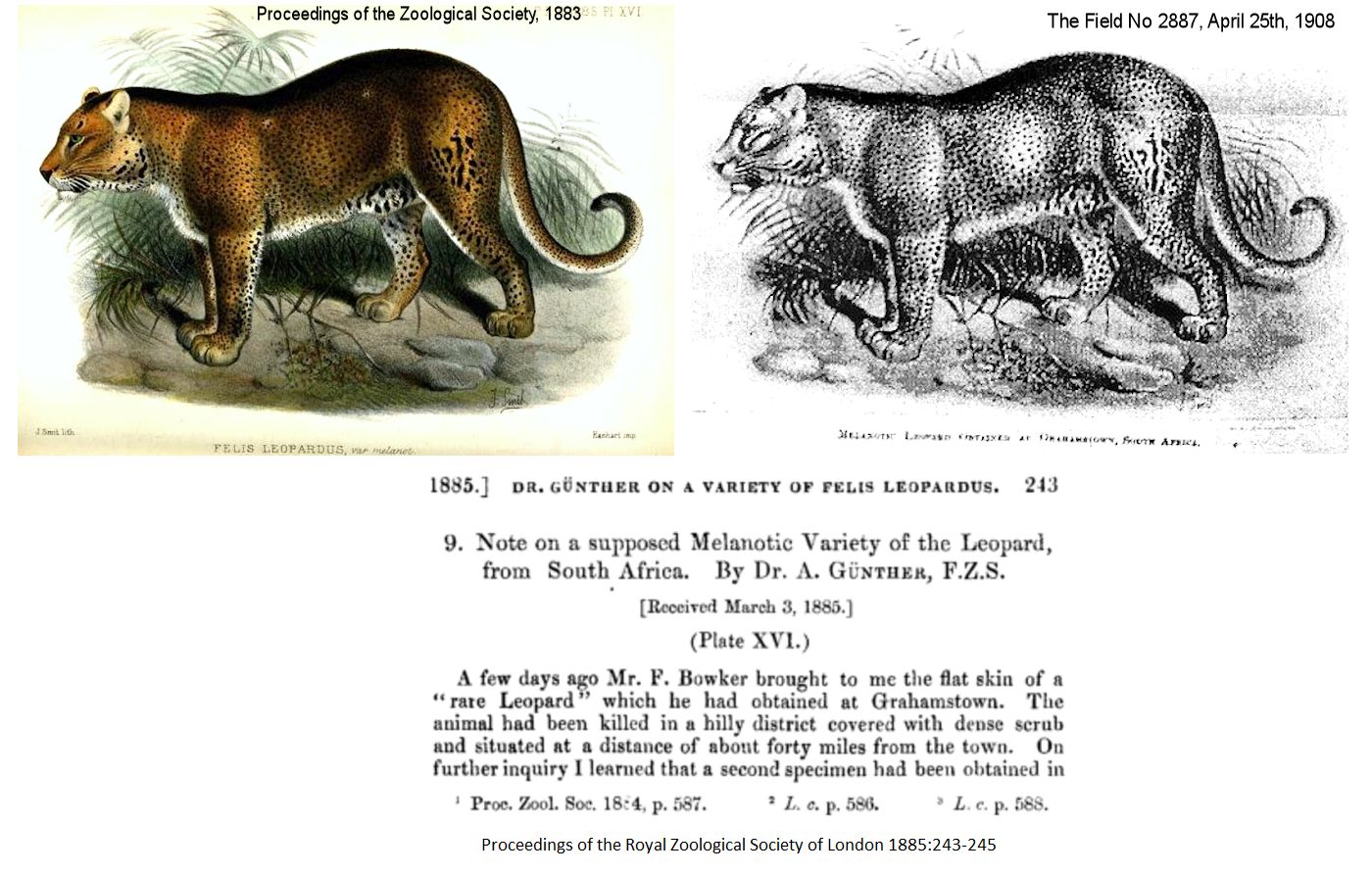
Pseudo-melanistic leopard, once posited as a leopard x cheetah hybrid |
W. L. Sclater s Mammals of South Africa, 1900, I, p. 36 37 describes South Africa s pseudo-melanistic leopards and observes that in South African leopards, pseudo-melanism (abundism) takes the place of the true melanism is found in Asian leopards.
Varieties. The leopard is an animal which varies a good deal both in size and in the colour and distribution of its markings, so that it has always been a doubtful question as to the number and validity of the species. Both in Africa and India sportsmen have been in the habit of distinguishing a smaller "hill" and a larger "plains " variety, the distinctions between which have been clearly pointed out by Kirby. The smaller has a rich buff ground colour and long thick fur, and the rosettes of the back run together somewhat so as to form several continuous stripes from the nape of the neck to the middle of the back. The animal measures on an average 6 ft. 5, of which the tail forms 2 ft. 10. The larger low country variety has very short far, with a pale fawn ground, and no sign of the black stripes along the back ; it is a lankier, longer animal than the other, and measures about 6 ft. 10, of which the tail forms about 2 ft. 6. Mr. Kirby, however, further states that these two described varieties are merely the extremes, and that intermediate forms are common, even commoner than the extremes, and that in no way can the two be considered as different species or even geographical races.
More distinct variations of the leopard sometimes occur. Dr. Gunther has described a very pale sandy variety from Matabeleland; but perhaps the most remarkable form is one noticed by Gunther and Trimen, of which three or four specimens have been obtained, all from the neighbourhood of Grahamstown, and of which an example has recently reached the South African Museum. This peculiar form shows no trace of the rosettes, but is covered, especially on the head and along the back, with a large number of small round black spots, which in one case were so numerous as to be fused together, so that the whole of the back and sides of the animal was quite black, while below and on the lower part of the legs the spots remain separate. In fact, this variety must be accounted as much a black " leopard " as any of those not infrequently found in Southern Asia. The difference, however, between the two varieties is an essential one, as in the Asiatic black leopard the melanism is caused by the darkening of the tawny ground colour, and the rosettes can be seen, somewhat like spots on watered silk in certain lights; whereas in the African variety the melanism seems to be caused by the great increase of the spots, which finally fuse to form a uniform black livery.
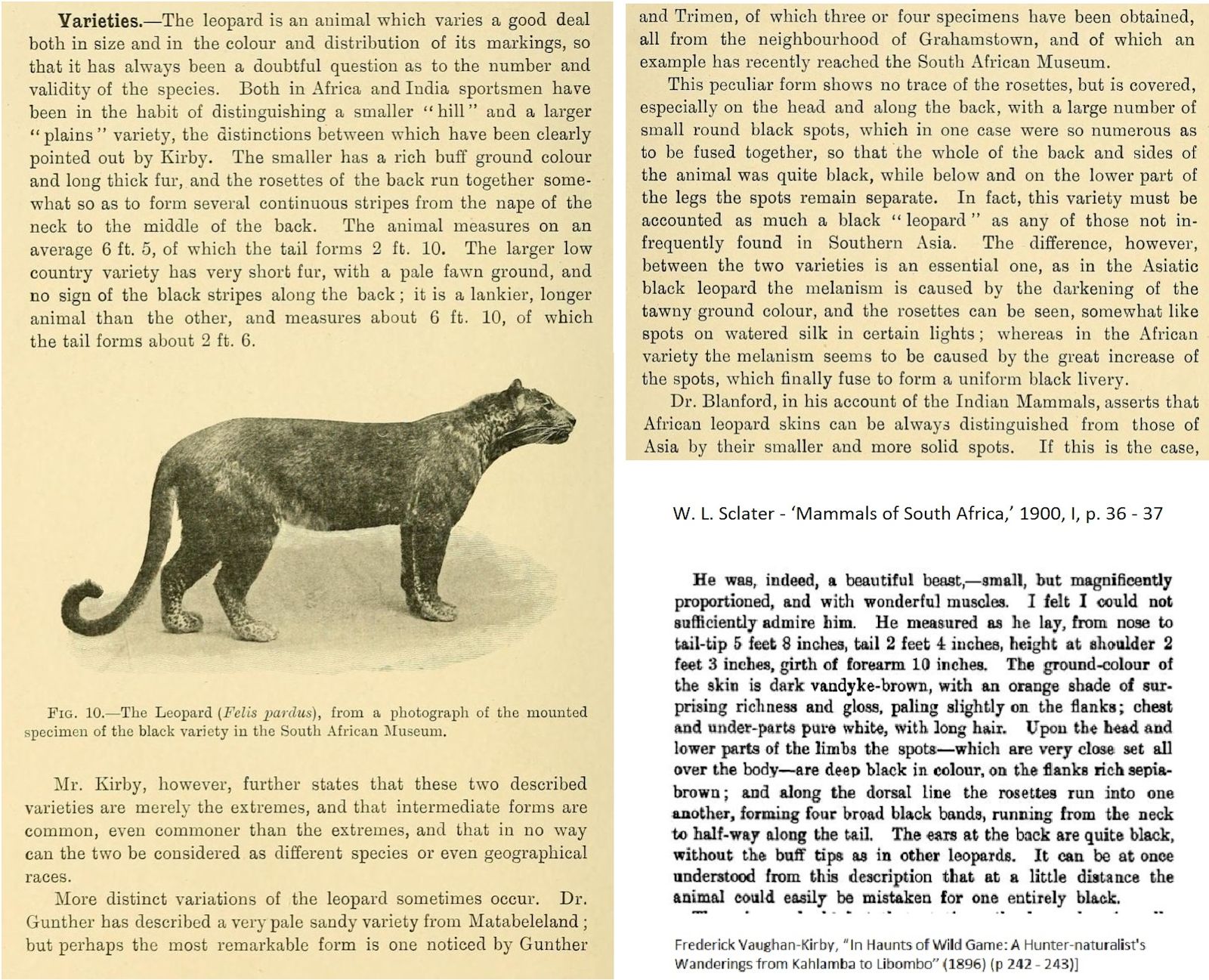
R. Lydekker wrote in "Game Animals Of India, Burma, Malaya, And Tibet," 1907 Another point is that there are no black leopards in Africa, although occasionally specimens are met with on the high grounds of South Africa in which practically the whole of the rosettes are broken up into minute, widely separated spots, while the ground-colour is darker than usual and the middle line of the back almost completely black. In one such specimen the semi-blackness of the back extends over the whole of the upper-parts, although the spots are still more or less distinctly visible.
In Harmsworth Natural History (1910), R Lydekker wrote: "In 1908, at one of the meetings of the Zoological Society of London, there were exhibited certain dark-coloured leopard-skins from Abyssinia, two of which were wholly black, while the others were what is called melanistic. These skins were made up into rugs, and it was also mentioned that other specimens of a similar character, reputed to come from Abyssinia, had been received on previous occasions in London, and treated in the same manner. The melanistic skins merely showed a deepening of the general colour, more especially on the two sides of the dorsal line; and an intensification of the same feature had evidently led to the production of complete melanism in the other two skins, both of which, when viewed in certain lights, revealed the existence of the normal black rosettes. in regard to general colouring these skins are, in fact, of the black Asiatic type. A similar skin has been obtained from Eastern Africa, hut in the rest of that continent black leopards seem to be unknown. There is, however, a peculiar dark phase in South Africa, a specimen of which was obtained in 1885 in hilly land covered with scrub-jungle, near Grahamstown. The ground-colour of this animal was a rich tawny, with an orange tinge; but the spots, instead of being of the usual rosette-like form, were nearly all small and solid, like those on the head of an ordinary leopard; while from the top of the head to near the root of the tail the spots became almost confluent, producing the appearance of a broad streak of black running down the back. A second skin had the black area embracing nearly the whole of the back and flanks, without showing any trace of the spots, while in those portions of the skin where the latter remained they were of the same form as in the first specimen. Two other specimens are known; the whole four having been obtained from the Albany district. These dark-coloured South African leopards differ from the black leopards of the northern and eastern parts of Africa and Asia in that while in the latter the rosette-like spots are always retained and clearly visible, in the former the rosettes are lost - as, indeed, is to a considerable extent often the case in ordinary African leopards - and all trace of spots disappears from the blacker portions of the skin. The idea has long been current that black leopards are much fiercer and more bad-tempered than those of the normal colouring.
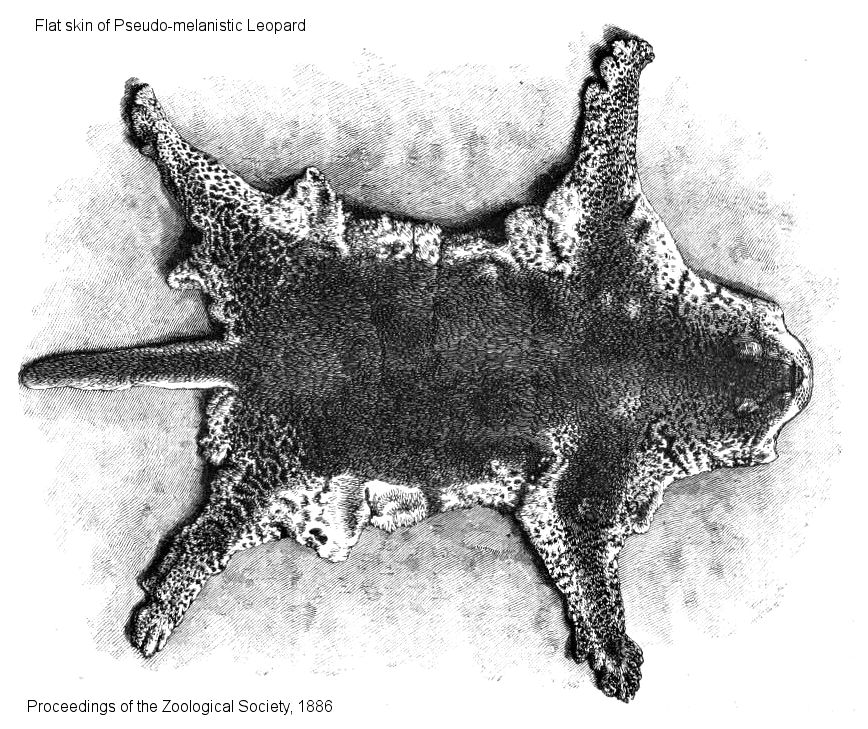
The skin of a pseudo-melanistic leopard leopard was described in 1915 by Holdridge Ozro Collins who had purchased it in 1912: The wide black portion, which glistens like the sheen of silk velvet, extends from the top of the head to the extremity of the tail entirely free from any white or tawny hairs [...] In the tiger, the stripes are black, of a uniform character, upon a tawny background, and they run in parallel lines from the centre of the back to the belly. In this skin, the stripes are almost golden yellow, without the uniformity and parallelism of the tiger characteristics, and they extend along the sides in labyrinthine graceful curls and circles, several inches below the wide shimmering black continuous course of the back. The extreme edges around the legs and belly are white and spotted like the skin of a leopard [...] The skin is larger than that of a leopard but smaller than that of a full grown tiger." The cat had been killed in Malabar, India in 1912 and was later identified as a pseudo-melanistic leopard. Two pseudomelanistic leopards are shown below.
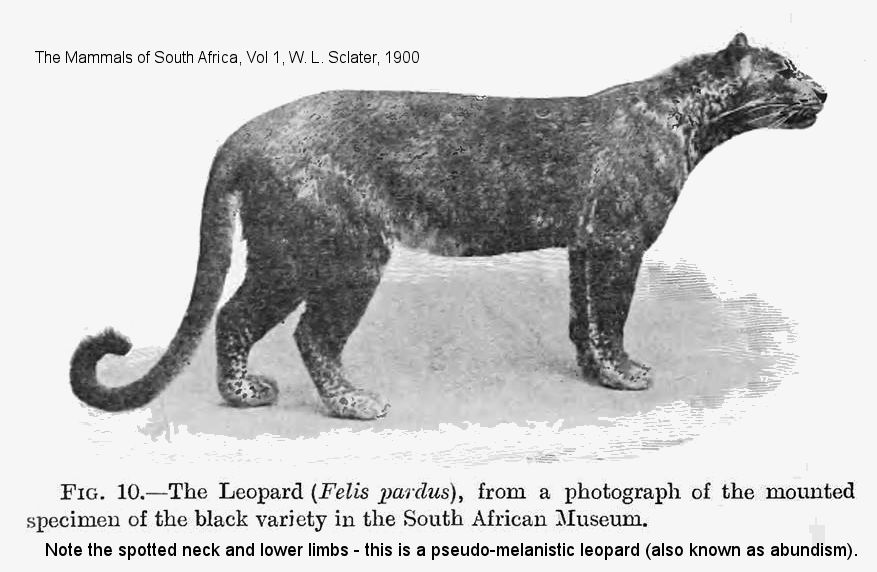
In May 1936, the Natural History Museum exhibited the mounted skin of an unusual Somali leopard. The pelt was richly decorated with an intricate pattern of swirling stripes, blotches, curls and fine-line traceries. This was very different to the pattern of spotted leopard, but rather similar to the pattern of the King Cheetah. Some modern cryptozoologists refer to the specimen as a King Leopard. Between 1885 and 1934, six specimens of pseudo-melanistic leopards were recorded from the Albany and Grahamstown districts of South, indicating that the gene mutation was present in the local leopard population. Others have been recorded from Malabar in southwestern India. The human penchant for shooting unusually patterned leopards appears to have wiped out individuals that carried the mutation.
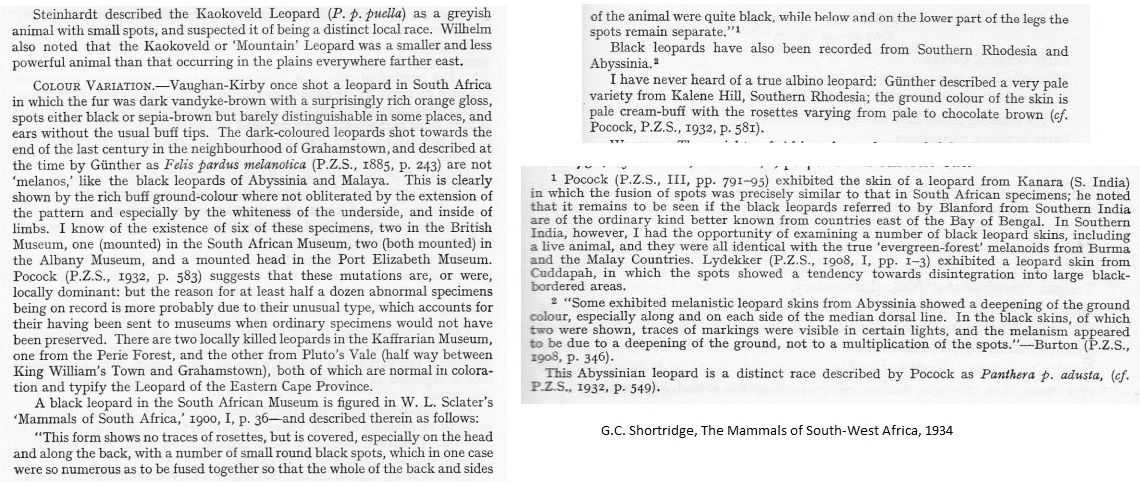
G.C. Shortridge, in The Mammals of South-West Africa, in 1934, listed a number of leopard variants in Africa: Steinhardt described the Kaokoveld Leopard (P. p. puella) as a grayish animal with small spots, and suspected it of being a distinct local race. Wilhelm also noted that the Kaokoveld or Mountain Leopard was a smaller and less powerful animal than that occurring in the plains everywhere farther east.
COLOUR VARIATION. - Vaughan-Kirby once shot a leopard in South Africa in which the fur was dark vandyke-brown with a surprisingly rich orange gloss, spots either black or sepia-brown but barely distinguishable in some places, and ears without the usual buff tips. The dark-coloured leopards shot towards the end of the last century in the neighbourhood of Grahamstown, and described at the time by Gunther as Pelis pardus melanotica (P.Z.S., 1885, p. 243) are not melanos, like the black leopards of Abyssinia and Malaya. This is clearly shown by the rich buff ground-colour where not obliterated by the extension of the pattern and especially by the whiteness of the underside, and inside of limbs. I know of the existence of six of these specimens, two in the British Museum, one (mounted) in the South African Museum, two (both mounted) in the Albany Museum, and a mounted head in the Port Elizabeth Museum. Pocock (P.Z.S., 1932, p. 583) suggests that these mutations are, or were, locally dominant: but the reason for at least half a dozen abnormal specimens being on record is more probably due to their unusual type, which accounts for their having been sent to museums when ordinary specimens would not have been preserved. There are two locally killed leopards in the Kaffrarian Museum, one from the Perie Forest, and the other from Pluto s Vale (half way between King William s Town and Grahamstown), both of which are normal in coloration and typify the Leopard of the Eastern Cape Province.
[Note: He was, indeed, a beautiful beast, - small, but magnificently proportioned, and with wonderful muscles. I felt I could not sufficiently admire him. He measured as he lay, from nose to tail-tip 5 feet 8 inches, tail 2 feet 4 inches, height at shoulder 2 feet 3 inches, girth of forearm 10 inches. The ground-colour of the skin is dark vandyke-brown, with an orange shade of surprising richness and gloss, paling slightly on the flanks; chest and under-parts pure white, with long hair. Upon the head and lower parts of the limbs the spots-which are very close set all over the body-are deep black in colour, on the flanks rich sepia-brown; and along the dorsal line the rosettes run into one another, forming four broad black bands, running from the neck to half-way along the tail. The cars at the back are quite black, without the buff tips as in other leopards. It can be at once understood from this description that at a little distance the animal could easily be mistaken for one entirely black. - Frederick Vaughan-Kirby, In Haunts of Wild Game: A Hunter-naturalist's Wanderings from Kahlamba to Libombo" (1896) (p 242 - 243)]
A black leopard in the South African Museum is figured in W. L. Sclater s Mammals of South Africa, 1900, I, p. 36 - and described therein as follows: This form shows no traces of rosettes, but is covered, especially on the head and along the back, with a number of small round black spots, which in one case were so numerous as to be fused together so that the whole of the back and sides of the animal were quite black, while below and on the lower part of the legs the spots remain separate." [Footnote 1: 1 Pocock (P.Z.S., III, pp. 791-95) exhibited the skin of a leopard from Kanara (S. India) in which the fusion of spots was precisely similar to that in South African specimens; he noted that it remains to be seen if the black leopards referred to by Blanford from Southern India are of the ordinary kind better known from countries east of the Bay of Bengal. In Southern India, however, I had the opportunity of examining a number of black leopard skins, including a live animal, and they were all identical with the true evergreen-forest melanoids from Burma and the Malay Countries. Lydekker (P.Z.S., 1908, I, pp. 1-3) exhibited a leopard skin from Cuddapah, in which the spots showed a tendency towards disintegration into large black-bordered areas.]
Black leopards have also been recorded from Southern Rhodesia and Abyssinia. [Footnote 2: Some exhibited melanistic leopard skins from Abyssinia showed a deepening of the ground colour, especially along and on each side of the median dorsal line. In the black skins, of which two were shown, traces of markings were visible in certain lights. and the melanism appeared to be due to a deepening of the ground, not to a multiplication of the spots."-Burton (P.Z.S., 1908. p- 346) This Abyssinian leopard is a distinct race described by Pocock as Panthera p. adusta, (cf. P.Z.S. 1932, p. 549).] I have never heard of a true albino leopard: Gunther described a very pale variety from Kalene Hill, Southern Rhodesia; the ground colour of the skin is pale cream-buff with the rosettes varying from pale to chocolate brown (cf. Pocock, P.Z.S., 1932, p. 581).
Proceedings of the Zoological Society, April 28, 1908: Mr. Henry Scherren, F.Z.S., exhibited on behalf of Mr. Walter Burton, F.Z.S., some melanistic and black leopard skins, presented to Mr. Clarkson Williams in Abyssinia, where they were obtained. The melanistic skins showed a deepening of ground-colour, especially along and on each side of the median dorsal line. In the black skins, of which two were shown, traces of markings were visible in certain lights, and the melanism appeared to be due to a deepening of the ground, not to a multiplication of the spots. Mr. Scherren stated that black skins from the same locality had been received by Mr. Rowland Ward, and, like these, made up into rugs. Mr. Ward, however, had preferred not to exhibit till he could procure skins obtained by a European sportsman.
A pseudo-melanistic leopard has a normal background colour, but its excessive markings have coalesced so that its back seems to be an unbroken expanse of black. In some specimens, the area of solid black extends down the flanks and limbs; only a few lateral streaks of golden-brown indicate the presence of normal background colour. Any spots on the flanks and limbs that have not merged into the mass of swirls and stripes are unusually small and discrete, rather than forming rosettes. The face and underparts are paler and dappled like those of ordinary spotted leopards

Pseudo-melanistic leopard or "king leopard" from Kerala, India |
In 2012, a pseudo-melanistic leopard was reported in the Parambikulam forests in the Palakkad district of Kerala (in the Western Ghats), India. The black spots were closely packed to give it a designer coat. In the case of the deer, the white spots on its reddish fawn coat were overshadowed by the black pigmentation, giving the animal a blackish appearance. In this dense forest habitat, melanism and pseudo-melanism may be an advantage to the leopard.
Guggisberg noted that leopards can be extremely variable in their patterns. In a paper about panthers and ounces of Asia, Pocock used a photo of a leopard skin obtained from southern India; it had large black-rimmed blotches, each containing a number of dots and it resembled the pattern of a jaguar or clouded leopard. Another skin from southern India shown by Pocock had the normal rosettes broken up and fused and so much additional pigment that the animal looked like a black leopard streaked and speckled with yellow.
CAN THE LEOPARD CHANGE HIS SPOTS. - The Airdrie and Coatbridge Advertiser, 1st February 1908, page 2: A mere leopard skin sent in from the Deccan, where there are leopards in plenty, is puzzling the British museum authorities at South Kensington. The markings on the skin, says Mr Lydekker, of the Museum, present a remarkable variation from the normal type, If we did not know the country of its origin we should have guessed that this wus the skin of a new species. The head and back are decorated with a big-meshed network of broad buff-coloured lines, the first mesh taking in the whole head. There are no tiger characteristics, or it might be guessed that we have here a tiger-leopard hybrid.
|
|
|
COBWEB LEOPARDS (VITILIGO)
In the early 1980s, Glasgow Zoo, Scotland acquired a 10 year old black leopard from Dublin Zoo, Ireland. She was exhibited for several years before apparently being sold to Madrid Zoo. The leopard had a uniformly black coat profusely sprinkled with white hairs, giving a silver "glitter" effect. The visual effect (of being draped with spider webs) led to her being nicknamed the "Cobweb Panther". The condition is known as piebaldism and has been seen in domestic cats. I have seen no reports as to whether the Cobweb Panther was ever bred to try to reproduce this effect. The condition is most easily seen on black cats. White spots appear on the coat; these become more extensive with age until the cat has a white lace pattern on the black fur. Ultimately the cat may go completely white. "Leukoderma" (white skin) and "Leukotrichia" (white hairs) are generic terms for piebaldism; it is a progressive "aquired depigmentation" i.e. a loss of pigment which occurs during the cat's lifetime and may be triggered by illness or environmental factors. Vitiligo is one form of leukoderma.
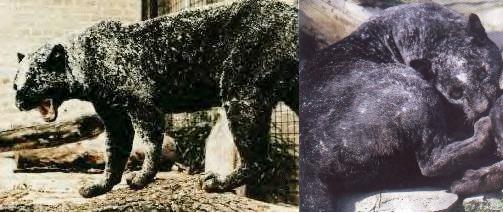
These two leopards, originally from the Woodland Zoo in Farmington, PA, were housed at the Farmers Inn in Segel, PA in 2010. The black leopard, Russell (original called Jasper) was born in Ohio and had two litter brothers, Lester and Leon, that did not survive. One brother was a conventional tawny leopard and the other was reportedly albino (whit with blue eyes). The female in this video, Sheba, is progressively greying due to vitiligo. An early photo shows her at the "cobweb stage" of the condition.

WHITE/PALE LEOPARD CUBS (FEVER COAT)
During the 1960s, one of two cubs born to a pair of normal spotted leopards at Colorado's Cheyenne Mountain Zoological Park was pure white, but apparently turned black at the age of five months.
The Orlando Sentinel, 2nd October 1974 reported the birth of two white Chinese leopards, Ming and Ling, on 10th September at the Rare feline breeding Compound run by Robert Baudy. It was the first time white cubs had survived in captivity. They had white fur, but black noses and feet (this might be fever coat where offspring are born unusually pale but develop normal colouration as they grow). The cubs were valued at $45,000 each. Their mother, Sing, was relatively old for breeding, which supports the theory of fever coat rather than a form of albinism.

ERYTHRISTIC LEOPARDS (STRAWBERRY LEOPARDS)
Other leopard mutants include red (erythristic) leopards with chocolate brown markings on a reddish background described as "rich mahogany". Buff leopards with orange rosettes have occurred; probably due to erythrism in a spotted leopard.
Proceedings of the Zoological Society, March 21, 1882.: Dr. Gunther, F.R.S., exhibited a flat skin of a very remarkable pale sandy-coloured variety of the Leopard (Felis pardus), from the Matabele district, South Africa, and pointed out its superficial resemblance in colour to the Woolly Cheetah (Felis lanea, Sclater) . [The woolly cheetah was erythristic, so the leopard exhibited by Dr. Gunther wouldhave been a so-called strawberry leopard.]
A wild erythristic spotted leopard was reported in April 2012 in South Africa's Madikwe Game Reserve. The male leopard, dubbed a strawberry leopard had a golden background with red spots and had been spotted by a number of tourists in the game reserve. Erythrism occurs when normal black pigments are not produced and red pigment is produced instead. This is possibly the result of the non-extension gene which is believed to be responsible for red leopards (black leopards where red had replaced the black colouration) and which is also seen in domestic cats. The red spotted coat still provides some camouflage (especially at dusk or night-time) and the "strawberry leopard" appears to be healthy and successful, but there is a fear that he could stray from the Madikwe Reserve into neighbouring game farms where he could be targeted by trophy hunters seeking a novelty.

Red spotted leopard (Strawberry Leopard), South Africa |
Assuming that not all red leopard specimens are due to discolouration of black leopard taxidermy specimen, how common is the mutation and what genes are involved? There seem to be fewer than 5 erythristic leopards reliably reported so it would either be a rare spontaneous mutation or a rare recessive gene. The most likely gene is the Extension gene which has been identified in domestic cats (it is also called "red factor", "black modifier" and "agouti modifier"). The dominant form of the gene allows normal expression of black pigment, but if a cat inherits 2 copies of the recessive form (non-extension) it produces red pigment instead of black. If a normal spotted leopard inherited 2 copies of the recessive non-extension form it would have reddish rosettes on a normal background colour. If a black leopard inherited 2 copies of the recessive non-extension form it would have deep reddish-brown spots on a reddish-brown background, exactly what is reported for "red leopards". Black leopards occur due to recessive genes for melanism and are not uncommon in the Indian subspecies, but rarely if ever occur in other leopard subspecies. Red leopards could only occur if a leopard inherited 2 recessive melanism genes plus 2 recessive non-extension genes.
|
Red leopard from collection of Mirko W lfling (University of W rzburg). It is believed this specimen came from a zoo and the red colour is due to the recessive form of the extension gene, not to taxidermy fading. |
|
Red leopard |
Red leopard taxidermy on display at a hunting supplies store. |
|
Red leopard or fading specimen? To the left is a melanistic leopard, to the right is a melanistic jaguar (face only). The black pigment tends to fade, giving an impression of reddish animals. The darker colour of the jaguar specimen may be due to the fact that jaguar melanism is a dominant mutation while leopard melanism is a recessive mutation. In other species, dominant black has been observed to fade less than recessive black. In an erythristic individual, the black pigment is turned to red, possibly due to the recessive form of the extension gene (red factor gene). |
|
|
Melanism gene (recessive) |
Extension gene (recessive) |
|
|
Normal spotted (black on tawny) |
0 or 1 copy |
0 or 1 copy |
|
Black leopard |
2 copies |
0 or 1 copy |
|
Red spotted (red/orange on buff) |
0 or 1 copy |
2 copies |
|
Red leopard |
2 copies |
2 copies |
LEUCISTIC AND ALBINO LEOPARDS
There are also pale cream leopards with pale markings and blue eyes (chinchilla mutants or dilute erythristics), striped leopards (possiblymis-identified as tiger/leopard hybrids), leopards with jaguar-like rosettes (darker central colour) and leopards without any distinct rosettes. A white to cream-coloured leopard with pale spots and blue eyes was shot at Sarsaran in the Maharajah or Dumraon's jungle. Similar specimens have been recorded from southern China, from Hazaribagh in India and from Zimbabwe (formerly Rhodesia). Pocock reported a purely white skin from East Africa; the spots were only visible in reflected light. Leopards with striped underparts have been noted. In Harmsworth Natural History (1910), R Lydekker wrote: The typical Indian leopard, as already mentioned, has the rosettes large and extending over most of the fore quarters. In the African leopard, on the other hand, the rosettes are everywhere smaller and more crowded, and on the shoulders and head break up into small solid spots. [...]. In ordinary leopards there are no black dots within the light area enclosed by the rosettes, but in some skins from Siam such dots are present, and thus serve to connect the leopard with the jaguar, in which they are normal.
R Lydekker wrote in "Game Animals Of India, Burma, Malaya, And Tibet," (1907) A white (albino) leopard has been recorded by Buchanan Hamilton. White panthers appear in Buchanan's painting from Malabar according to Walker in "Buchanan's white leopard of Malabar" (1996). In Harmsworth Natural History (1910), Lydekker wrote: Far rarer than black leopards are white ones, of which but very few have been met with.
It is necessary to be careful when reading historical accounts of white leopards. For example, in "A Trip To Cashmere And Ladak," by Cowley Lambert, F.R.G.S. (1877), the author wrote "going away up another ridge about five hundred yards off was a splendid white leopard," but this turns out to be a snow leopard "This was the only time I saw the snow-leopard ... It is of a yellowish colour, but white in places, with perfectly black spots and a very long tail.
In "The Wildlife of India" by E.P. Gee wrote that in 1947, a letter in "The Statesman" of Calcutta asked "Who has ever seen a white leopard?" The question was answered a few years later in "The Field" describing a leopard skin obtained from a leopard shot in a princely state near Patna, Bihar: "The colouring was not due to albinism but lacked melanistic characteristics, there being no black markings, and the colour being of various shades of orange and cream resembling that of a really good tortoiseshell cat." Another very pale-coloured leopard was reported in "The Field" in 1953 regarding London Zoo's leopard from West Persia exhibited in 1910 or 1911: "indistinct, blackish spots in summer. When autumn came its now longer winter coat lost the spots and became so pale as to be difficult to see towards dusk." The latter suggests the chinchilla mutation where the pigment is only deposited towards the ends of the hair shaft; the longer the hair the paler the effect.
Mel and Fiona Sunquist wrote in "Wild Cats Of The World" "Albino leopards have been reported from India, China, Zimbabwe, and East Africa, but the instance of albinism appears to be rare. Pocock reports having seen only one true albino skin, which he believed came from Africa, but he also records a partially white skin in the British Museum in which the ground color was a cream and the markings tan.
A 1993 issue of the Journal of the Bombay Natural History Society contained an article listing instances of albino, or partial-albino, leopards noted between 1905 and 1965. Most are from the Bihar and Madhya Pradesh areas of India and three were in sufficiently close proximity that there may have been a degree of inbreeding in the region. According to this paper, "Mutant Leopards from India" by Divyabhanusinh, "As far as leopards are concerned, the phenomenon appears to be extremely rare and very few records exist. I have consolidated here all the instances I have come across which should be of interest to readers of the Journal.
1. In 1905 there was a report of a light coloured animal from Central India: One leopard (tainchia) of sandalwood (sandli) colour was killed at Jhinna [near Ajaigarh, Panna District, M.P.]. It was a very large leopard. Such a sandalwood coloured leopard has not been seen or heard of and its skin still exists today (Ajaigarh 1914, p.47).
2. In c. 1910 a white leopard was reportedly shot in Dumraon in Bihar, of which there are no details (Musselwhite 1933, p. 104).
3. In 1937, there was a likely report of a police officer having shot a white leopard in Dumraon; there is no skin in existence of this specimen (Musselwhite 1933, p. 104).
4. In 1940 a white female was shot by a Boris Lisscnovitch 15 miles from Sarasaran (sic) near Dumraon. When shot the eyes were sky blue - there was no trace of pink in the eye - and the tail shows just a suggestion of the original leopard. The animal is white at the sides and cream towards the centre with pale brown spots. There is a picture of a white leopard in the same report (presumably the same animal) which was six years old and was 6'6" between pegs (Musselwhite 1933, pp.97, 104). The book from which three of the above records are cited was published in 1933 and nowhere in it are a subsequent edition and date mentioned. Yet, its text gives the date as February 1940 of the white leopards at number 4 above. This is clearly an error and the correct date could well be 1930. If so, the dates of the animals referred at 2 and 3 above would be different as well.
5. There is yet another instance of a male white leopard, about 6'9" in length, with sandalwood coloured light spots on its body, which was shot by a villager c. 1965 in village Aramgang of Ajaigarh tehsil of Panna district, Madhya Pradesh. This is not very far from Jhinna mentioned in 1 above. The skin was acquired by the late Raja Bahadur Kaushalendra Sinhji and the mounted trophy is in the Ajaigarh Palace (Vansda, pers. comm. 1984).
6. M/s Van Ingen & Van Ingen of Mysore have recorded receiving a white leopard skin from Tikamgarh near Orcha in Madhya Pradesh (Van Ingen, pers. comm, to Vansda, 1967). The Maharaj of Orcha informed he has been unable to find any information regarding this specimen (pers. comm. 1991).
7. One skin of a leopard from Hazaribagh in which the ground colour is much paler than usual, almost cream and the pattern is tan is preserved in the British Museum, London (Pocock 1939, p.224).
8. A white (albino) leopard was recorded by Buchanan-Hamilton according to one source (Lydekker 1907, p.318), while another states that Blanford cites a figure of a white one [leopard] in Buchanan-Hamilton s drawings (Finn 1929, pp.84-85).
9. One skin which was normal except for having the spots light brown instead of black has been recorded but no further details are available (Finn 1929, p.85).
From this examination it may be observed that three instances are from Dumraon and one from Hazaribagh, both in Bihar, and three are from Ajaigarh and Orcha in Madhya Pradesh.
From the Dundee Courier (2nd March 1909) there is a report of a white leopard killed in East Africa. White African Leopard. What is probably the first white leopard recorded from Africa, was shown at the German Sporting Exhibition, recently held in Berlin. It was shown by Mr Otto Bock, end known to been killed near Dar-es-Salaam, but the name of the sportsman has not yet been ascertained. The ground-colour is said to be quite white, on which rosettes show faintly as dark spots The late Dr Blanford, in the volume " Mammals of the Fauna of British India," referred to a white (albino) leopard figured in Buchanan Hamilton's drawings. But the drawings appear to be unpublished, and Dr Blanford gave no description of the animal. It was reported again in the Illustrated Sporting and Dramatic News (16th December 1911) A pure white leopard was shot in German East Africa a year or two since. Such a specimen is extraordinarily rare. That latter publication printed a report and a photo in 1925, showing the taxidermy mount of the white leopard
An account of the shooting of a white leopard in India is contained in the book Tiger for Breakfast by John Burroughs (1921):
Boris [Lissanevitch ] did hold and still holds a unique distinction that of having shot the only white leopard on record. This occurred on a shoot with a great friend of Boris's, the Maharaja of Dumraon, whose large estates covered a part of the present state of Behar, lying west of Bengal along and south of the Nepalese border. From 1938 on Boris would hunt every year with the maharaja in Assam, in addition to the numerous shoots he would share with Dumraon on his estate. In 1942 Boris and Kira went for a shoot with the Maharaja and Maharani of Dumraon in Behar, in a forest neighboring the town of Sassaram. . . . They walked some hundred yards from camp and sat down on a little path, fifty yards from each other. The beaters started their work, slowly drawing toward the path. They were not far off and could be heard shouting, but yet nothing flew or walked out of the forest. It looked as if their bad luck was holding out. Then suddenly, about thirty yards away, Boris saw a stranger-looking animal. It was definitely a leopard, but with something wrong about it. . . . As Boris hastily fired again, the animal somersaulted and disappeared in the bush.
'What have you shot?" asked Dumraon, coming up.
"A strange-looking leopard," said Boris.
To their amazement, the leopard was unlike anything they had ever seen. Its body was completely white, except that the spots which should have been black were a pale cream or sandy color. One might have thought that it was an albino, but its blue eyes and a detailed examination proved this was not the case, and that it was simply a freak of nature. The leopard measured six feet, six inches, from nose to tail. The skin was immediately sent to the famous taxidermists Van Ingen & Van Ingen of Mysore. There a complete examination and report were made on the skin. The only skin resembling it one that had been brought to the Van Ingen firm for examination forty-five years previously was a badly damaged one whose origin and present whereabouts were unknown. Complete information was forwarded by the Van Ingens to the Bombay Natural History Society, where the record was duly registered and the unique particulars of the animal noted. Later an article in Natural History magazine of Bombay discussed the white leopard. An account of this unique trophy is also given in Arthur Musselwhite's book Behind the Lens in Tiger Land. The Maharaja pleaded for the skin and Boris, much to the chagrin of his wife, gave it to him. Today the skin is in the possession of the Maharaja of Dumraon's son.
Various theories have been advanced to explain this freak white leopard. If white leopards were believed to be almost nonexistent until Boris's specimen was shot, a certain number of white tigers have been found, and the Maharaja of Rewa has now managed to breed a white tiger which has sired cubs like its father, pure white with dark stripes and blue eyes. Boris believes that the coloration of white tigers and leopards is due to the presence of certain minerals in the soil. Nearly all white tigers that have been captured or shot were found in the vicinity where Boris bagged his leopard, in Bchar around Takari, Rewah and Sarguja, a geographical area with formations of limestone. It is believed that this mineral or some other in the water or the salt licks may be responsible for the pigmentation of these freaks.
Illustrated Sporting and Dramatic News (28th November 1925): AN ALBINO LEOPARD. THE illustration shows a fine specimen of a white leopard, shot in the Tanganyika Territory, near Dar-es-Salaam, in East Africa. Albino specimens of the leopard, or panther, as it is usually called in India, are extremely rare; in fact, in a long experience of the fauna of Africa I cannot recall another example. [. . .] This very fine example of the white leopard was mounted by Messrs. Rowland Ward, of Piccadilly. It was acquired by Lord Rothschild, to be added to the splendid collection in his museum at Tring. H. A. Bryden.
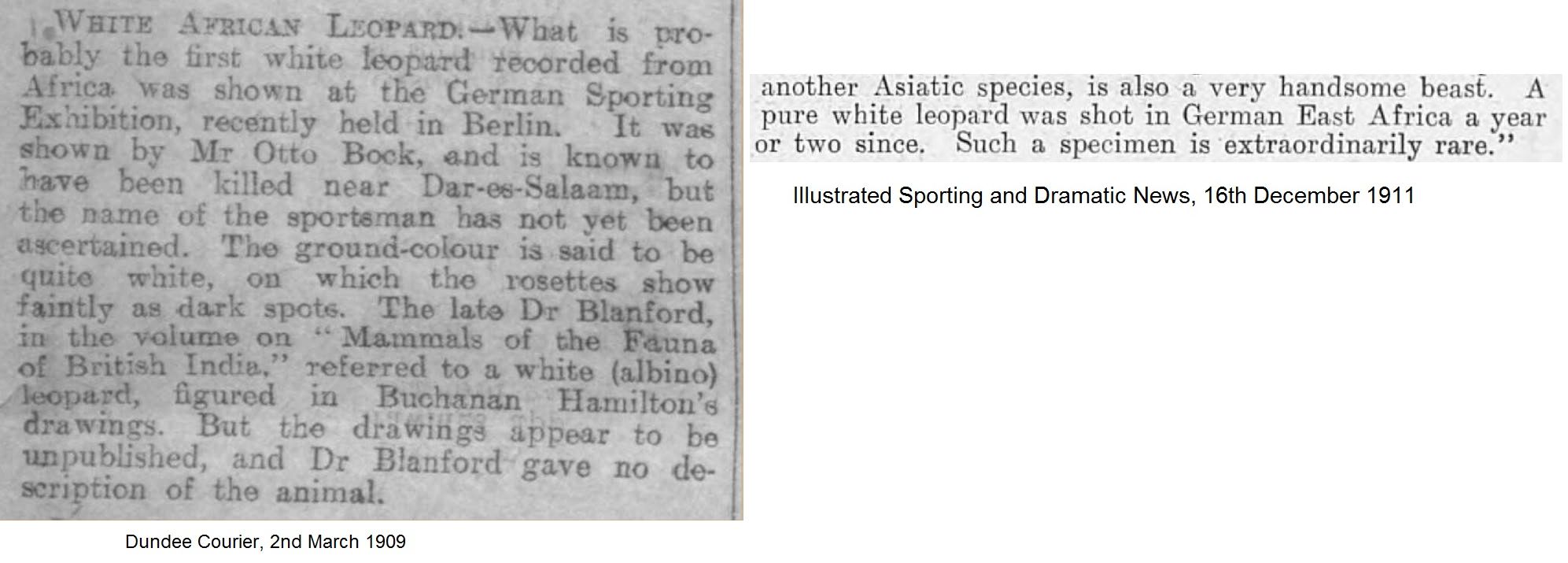
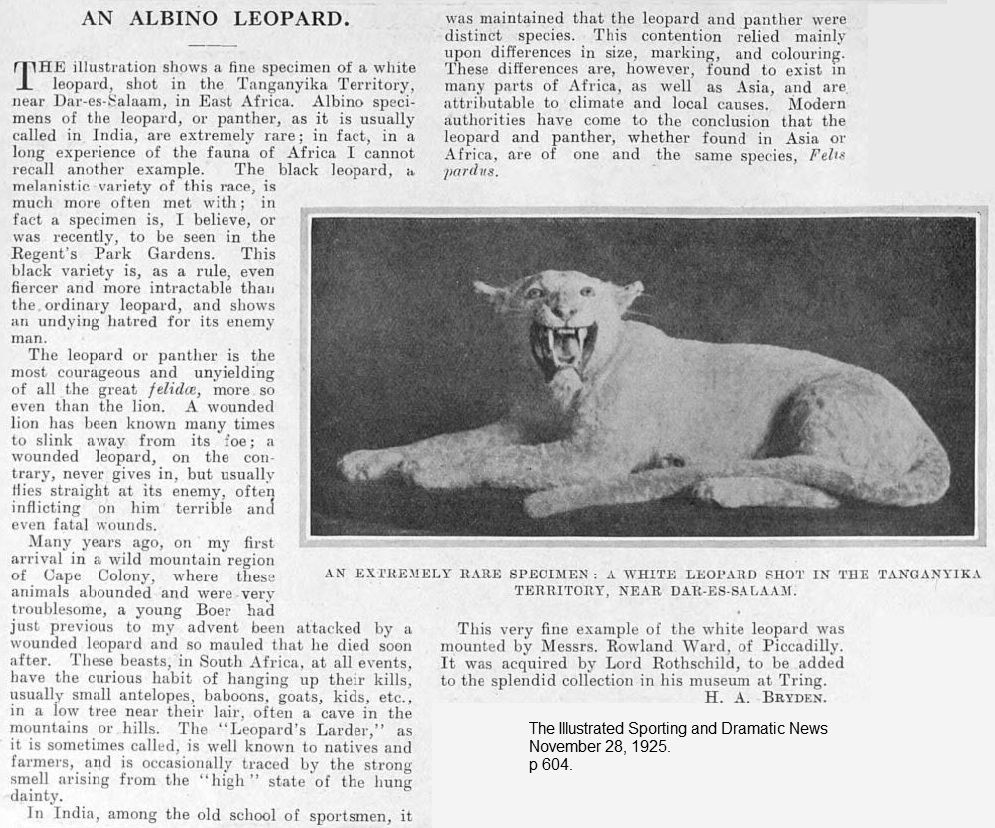

Unlike melanism, albinism could make a leopard more conspicuous and a less successful predator. Being both unusual and conspicuous, albino leopards would have fallen victim to big game hunters' guns. A wild-caught albino leopard called Jinx was apparently kept at the Central Park Zoo, USA between 1935-1960 and had originated from Mozambique; descriptions suggest a degree of ghost spotting. In "Management Of Wild Mammals In Captivity", the albino leopard at the Central Park Zoo was described as "An albinistic specimen of the tall East African race (Panthera pardus pardus) recently living in the Central Park Zoo, was a beautiful creature. Its ground color was pale buff, almost white, its spots were very light brown, and its eyes were pink. This animal, a male, was brought from Mombasa, with a normally colored male companion, as a 'leopard by lion hybrid.'" White leopards were apparently born at Los Angeles (USA) Wildlife Weighstation; these were leucistic i.e. white but with normal colour eyes. They developed spots as they grew older. A white, but apparently not albino, leopard cub born in Africa was sold to a zoo in Japan in the spring of 1999 and is called "Nana". Two leopard cubs were born at the Wildlife World Zoo in Arizona; one, named "Isis" was believed to be the only white leopard to be born in captivity. Several experts have confirmed that she has white skin, though she was described as having spots. Blood tests on Isis and her parents were planned if her skin remains white. Claws 'N' Paws Wild Animal Park, Pennsylvania also claims a white leopard.
On 6th May 1978, a pair of white leopard cubs were born to normal (spotted) leopards are Rome Zoo. Both had to be hand-reared. The male cub was whitish with light grey spots and died shortly afterwards. Post mortem showed internal abnormalities. The female survived and was snow white in colour. As she grew older, her coat turned pale grey and the spots became visible.
|
COLOUR MORPHS OF LEOPARDS |
|
|
Tawny (orange/normal) |
Black (melanistic) |
|
Albino (pink-eyed) |
Black (pseudo-melanistic) |
|
Red |
Cobweb (captivity only) |
|
Cream |
Blue (maltese) (unconfirmed) |
BLUE-GREY LEOPARDS
There has also been a claim of an "ashy grey leopard" with charcoal spots in India . This could be analogous to the Chinese blue tigers (maltese mutation) though it has been suggested that the animal had dust-bathed in ash from a fire, or had simply been observed in poor light. On 16/01/2009 the BBC2 Natural World documentary "The Mountains of the Monsoon" featured wildlife photographer Sandesh Kadur in the Western Ghats, India. The Western Ghats have diverse wildlife, including previously undescribed species. Ten years previously, Kadur had observed a greyish big cat in broad daylight in the high-altitude grasslands around Anamudi, the highest peak south of the Himalayas. It was large, long-tailed, had rounded ears and a uniform darkish grey colour which did not correspond to any known big cat. It was known to locals as the pogeyan ("the cat that comes and goes with the mist"). Kadur set up camera traps, but the pogeyan did not appear. Although Kadur hoped it might be a species new to science, he was realistic that a more likely identity was an aberrant form of leopard, possibly albino (he didn't mention chinchilla (cream coloured) leopards, but these are also known). The "cobweb" leopard can also appear solid grey from a distance due to the salt-and-pepper sprinkling of white hairs in the coat. The drawing of its conformation more closely resembled a lioness, which could indicate an isolated montane form of Asian lion (their known range is the Gir forest).
OTHERS: SHORT-TAILED, TAILLESS, LONG-HAIRED AND PYGMY LEOPARDS
As well as colour variations, tail-less and short-tailed leopards have been reported. This might have been due to gene mutation, a birth defect (e.g. strangulation of the tail by the umbilical cord) or injury. The telling factor is to see whether the tail-tip has the normal black tip - if it hasn't, the tail has been lost accidentally. Inexperienced females have been know to accidentally bite off their offspring's tails (or worse a leg) during excessive grooming. In Harmsworth Natural History (1910), R Lydekker wrote of a pigmy leopard "In Somaliland occurs the smallest of all leopards (F. pardus nanopardus), in which the spotting is largely of this small solid type, while the ground-colour of the fur is greyish white. " In 2003, I heard of a longhaired leopard sighting in Africa, but received no further information or geographical information. It had the normal spotted pattern, but diffused by the longer fur (leopards normally have short, sleek fur). Since the longhair mutation is due to a recessive gene, if the apparently longhaired leopard had produced offspring then some will be carriers and the longhair mutation may turn up again.
It's worth noting that the true Amur leopard pattern is unlike that of any other leopard subspecies. The rosettes are widely spaced and of large size with very thick margins, which are usually closed. Hybrids are much like an average leopard except slightly long-haired. Their rosettes are closer together and often of smaller size, with thinner, broken margins. Pure Amur leopards have quite long legs compared with hybrids. (Long Island Ocelot Club Newsletter May/June 1991)
Textual content is licensed under the GFDL.
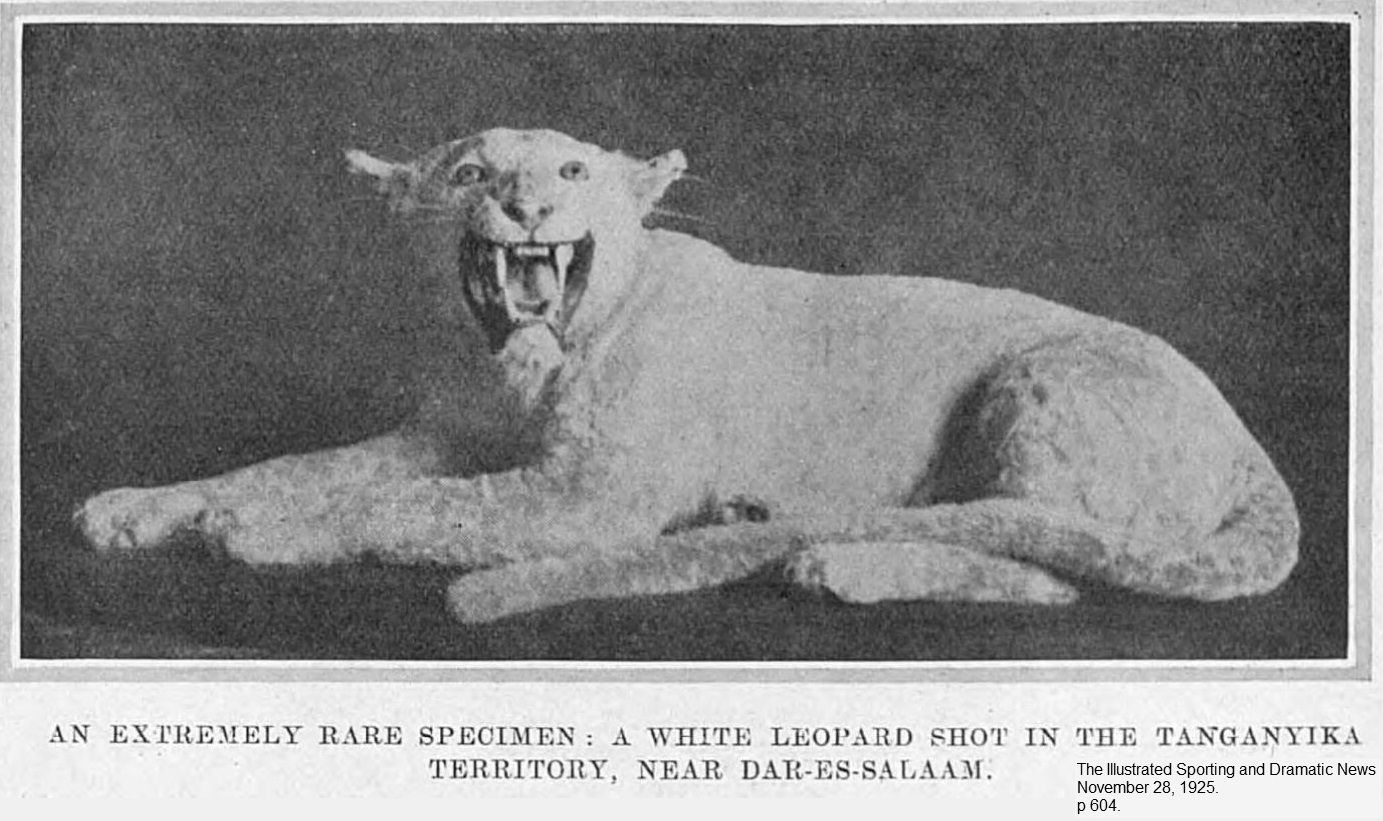
For more information on the genetics of colour and pattern:
Robinson's Genetics for Cat Breeders & Veterinarians 4th Ed (the current version)
Genetics for Cat Breeders, 3rd Ed by Roy Robinson (earlier version showing some of the historical misunderstandings)
Cat Genetics by A C Jude (1950s cat genetics text; demonstrates the early confusion that chinchilla was a form of albinism)
Moiser, C. 1997. The melanotic leopards of Eastern Cape, South
Africa. In Downes, J. (ed) The CFZ Yearbook 1997. CFZ (Exeter), pp.
43-50.
For more information on genetics, inheritance and gene pools see:
The Pros and Cons of Inbreeding
The Pros and Cons of Cloning
|
BACK TO HYBRID & MUTANT BIG CATS INDEX |